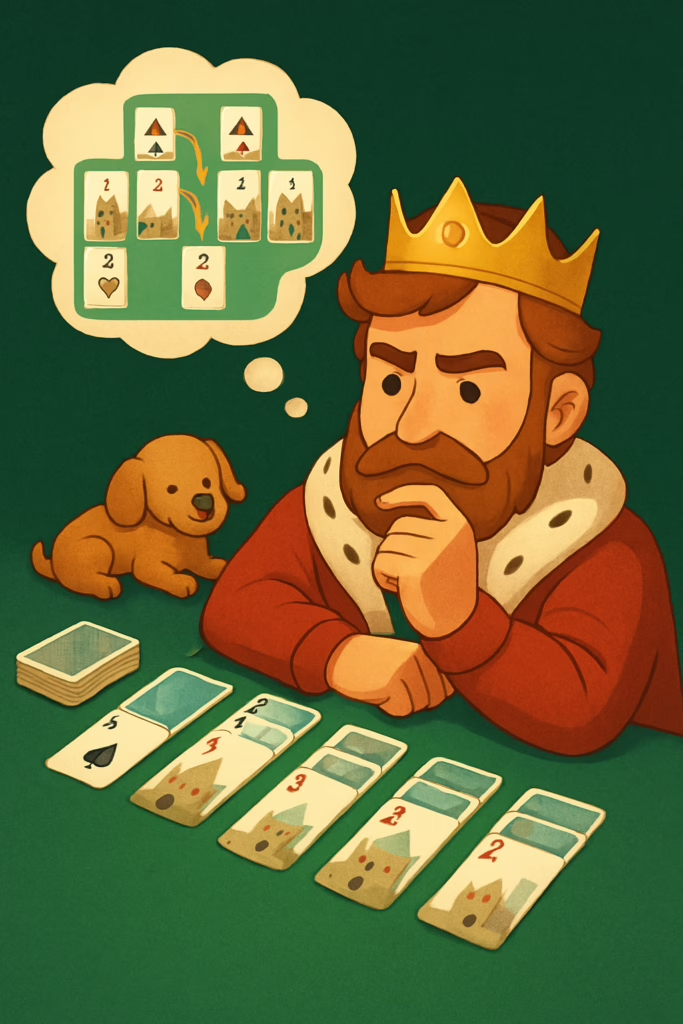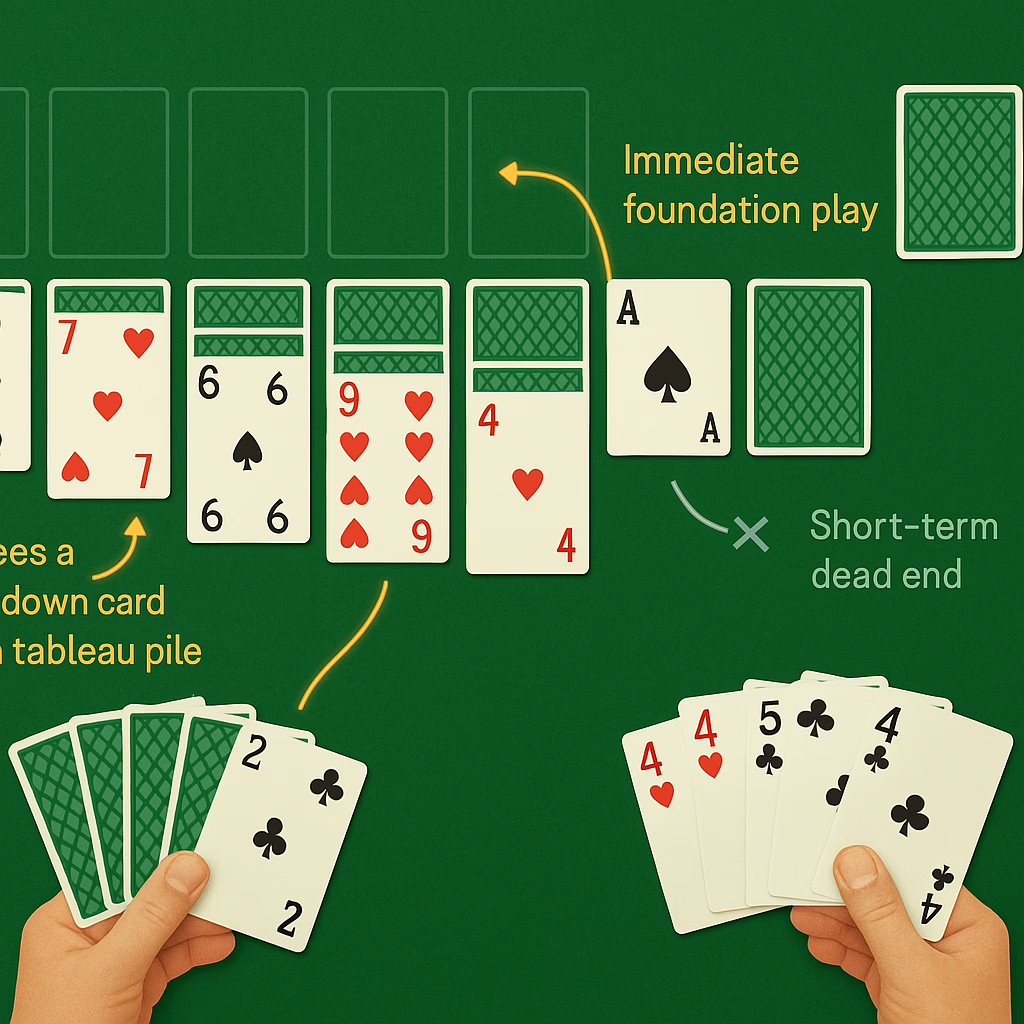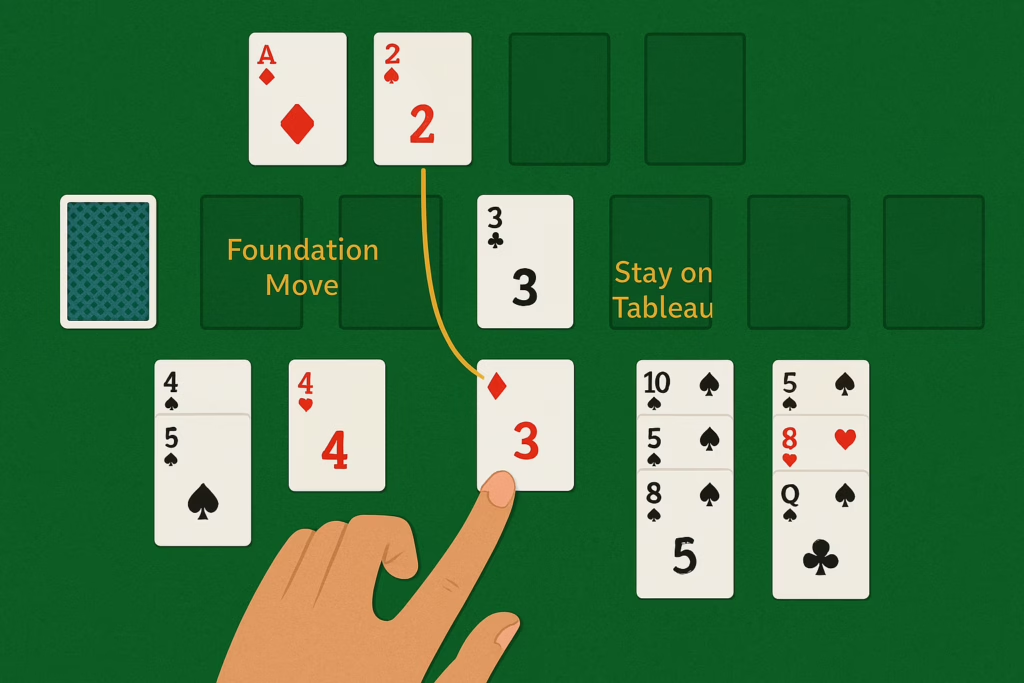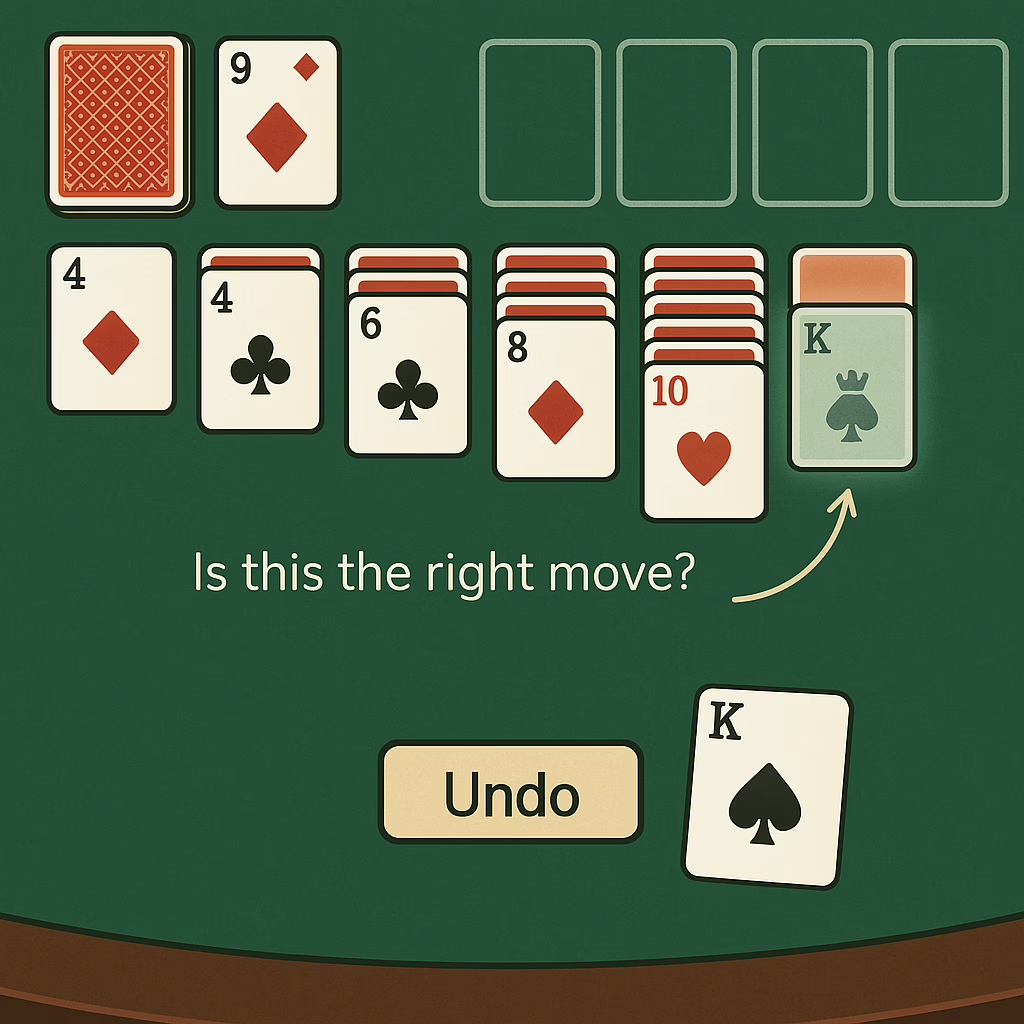1. Introduction
Solitaire, also known as Patience in many parts of the world, is one of the most widely played single-player card games. Its popularity springs from its accessibility—you only need a standard deck of 52 cards (or a digital version of the same) and some free time. While many people think of Solitaire as a leisurely pastime, there is an entire subset of players devoted to mastering the game with speed and efficiency.
Winning Solitaire in fewer moves is both a science and an art. It involves a blend of logical thinking, memory, planning, pattern recognition, and sometimes intuition. Most importantly, it requires discipline and practice. This blog post will guide you through methods, tips, and frameworks you can use to reduce the number of moves it takes to win a typical game of Klondike Solitaire (the most popular version), though the strategies often translate well to other variations.

Whether you are brand-new to the game or a seasoned veteran looking to trim down your move count, this guide will help you become a more efficient player. Along the way, we’ll sprinkle in practice drills, skills to master, and illustration prompts so you can visualize precisely what each tip entails.
Quick Note on Terminology: In Klondike Solitaire, there are several key areas:
- Tableau: The seven columns of cards where you build in descending order and alternate colors.
- Foundation: The four stacks at the top (usually) where you ultimately want to build up each suit from Ace to King.
- Stock: The undealt pile you flip cards from.
- Waste: The face-up pile where cards go once flipped from the stock.
Let’s dive in!
2. Understanding the Basics
Before trying to cut down on the number of moves, it’s crucial to have a solid handle on the rules and structure of Solitaire (Klondike). In Klondike, the main objective is to get all four suits into their separate foundation piles at the top, each starting with an Ace and ending with a King. Meanwhile, on the tableau (the seven piles on the main board), cards must be placed in descending order, alternating red and black suits.
Why mastering the basics matters: If you don’t have the standard rules etched into your memory, you’ll spend unnecessary mental energy figuring out whether a move is allowed, inadvertently adding moves or missing opportunities.
Key point: You can only move one card at a time unless you have a complete or partial sequence of cards already stacked in descending order and alternating colors; in that case, you can move the sequence as a unit.
Practice: For a few sessions, focus entirely on legal moves and the standard patterns. Don’t think about minimizing moves—just get comfortable with the game’s flow. After you’re confident, you can systematically incorporate advanced strategies.
3. Tip #1: Learn Effective Card Prioritization
3.1 What Is Card Prioritization?
Card prioritization is the art of determining which cards (and columns) to move first when multiple moves are possible. In Solitaire, not every legal move is beneficial, especially if you’re aiming to minimize your total moves. Making random or suboptimal choices can trap valuable cards behind others, forcing you to backtrack or deploy more moves later.
3.2 Why It Helps Reduce Moves
- Fewer wasted flips: By understanding which moves unlock the greatest potential for progress, you’ll reduce the number of times you cycle through the stock or rearrange the same column.
- Streamlined foundation building: Prioritizing moves that free up Aces and low-value cards early helps accelerate foundation growth, which is a crucial milestone to finishing with fewer moves.
3.3 Concrete Strategies
- Always reveal facedown cards on the tableau as soon as it’s beneficial: Each facedown card is a potential gateway to an entire new sequence or an Ace you can build on the foundation.
- Free columns (empty tableau slots) quickly: Empty tableau slots are invaluable because you can move entire stacks to them. They also provide a home for Kings (and any sequence starting with a King), which can drastically reorganize the tableau in one move.
3.4 Practice for Card Prioritization
- Drill: Set up a game, and before each move, ask yourself: “Which move will reveal the greatest number of new opportunities?” or “Will this move potentially lead to an immediate increase in foundation cards?”
- Record and Evaluate: Keep track of your moves for each game. If you see you’ve taken a detour (like moving a card that doesn’t free a new facedown card or doesn’t progress your foundation), reflect on how you could have prioritized differently.

4. Tip #2: Maximize Tableau Mobility
4.1 The Role of the Tableau
The tableau is the workspace of your Solitaire game. It’s where you’ll arrange columns in descending order, shuffle partial sequences around, and reveal facedown cards. If you can keep the tableau as fluid as possible, you can maneuver your cards into prime positions faster and with fewer moves.
4.2 Techniques to Improve Mobility
- Don’t cluster too many high-value cards in one column: A top-heavy column (like multiple Kings and Queens) can be challenging to move around because you can only place a King in an empty space.
- Leverage empty columns: An empty column is often the difference between a stuck game and a fluid one. Whenever you get a column completely cleared, prepare to use it to rearrange or stage sequences.
- Be cautious about burying essential cards: If you have a red Jack that can move to a black Queen in one column, but you also have the same color Jack that might be used more effectively in another column, think carefully about which is best to move. Unnecessary burying can cause extra moves.
4.3 Practice for Tableau Mobility
- Column Rebuild Challenge: Mid-game, pause and see if you can rearrange existing sequences into fewer or more extended columns. Focus on clearing one column entirely. This trains your eye to spot mobility-enhancing moves.
- Constraint Mode: Sometimes set a self-imposed limit on how many times you can move a single card. This forces you to value each move’s impact.
5. Tip #3: Optimize Foundation Builds
5.1 The Foundation’s Importance
The entire point of Solitaire is to stack all suits (Ace to King) onto the foundation piles. However, rushing to place certain cards on the foundation too early can sometimes hinder your mobility on the tableau. On the other hand, delaying foundation moves can crowd your tableau unnecessarily. Balancing these two extremes is a critical factor in minimizing moves.
5.2 Balancing Early and Late Foundations
- Early Aces: Whenever you see an Ace, prioritize moving it to the foundation if it doesn’t compromise a critical tableau arrangement. An Ace sitting on the tableau rarely benefits your mobility.
- Smart Sequencing: If you have a 2 and 3 of the same suit on your tableau, it might be wise to keep them accessible until you’re sure they won’t be required to help reorganize columns. Once you place them on the foundation, you lose their utility in building alternate color sequences on the tableau.
- Foundation or Tableau?: Occasionally, holding a low-value card (like a 3 or 4) in the tableau is beneficial if you need it to place a 2 or 3 of an opposite color on top. Each scenario is unique.
5.3 Practice for Foundation Building
- Suit-Selective Drills: Try focusing on building just one suit quickly (like all hearts) onto the foundation, while leaving others in the tableau. Then reflect on how that early foundation buildup impacted your moves.
- Foundation Delay Challenge: Play a few games where you deliberately delay placing cards onto the foundation to see if you can create more flexible rearrangements on the tableau. Then compare how many moves the game took versus your usual approach.

6. Tip #4: Plan Stock and Waste Pile Moves Carefully
6.1 Role of the Stock and Waste
The stock is the deck from which you flip new cards. The waste is where those flipped cards go if you cannot place them immediately onto either the tableau or foundation. Minimizing moves means maximizing how many cards you can place without having to continuously recycle through the stock.
6.2 Techniques to Handle the Stock
- Preview Next Flip (in digital versions): Some digital Solitaire games let you glimpse upcoming cards, giving you a significant advantage in planning. Use it if available.
- Don’t Flip Recklessly: If you can make moves on the tableau or foundation that might open space for an upcoming card, do so before flipping the next card.
6.3 Waste Pile Strategy
- Pay Attention to the Order: If you know the next card in the waste could be placed onto an empty column or an existing sequence, be deliberate. Sometimes you might hold off flipping the next stock card to keep that waste card on top.
- Cycle Minimization: Every time you pass through the stock without effectively placing cards, you add moves. Try to ensure each pass reveals new playable cards.
6.4 Practice for Stock/Waste Management
- Waste-Tracking Drill: For each card you flip onto the waste, note whether you could have placed it immediately if you had arranged the tableau differently. This post-game analysis will help you see missed opportunities.
- Stock Restriction: Limit yourself to only one pass through the stock. This forces you to be extremely strategic about how and when you make moves on the tableau/foundation.
7. Tip #5: Maintain Tableau Diversity
7.1 Why Color and Rank Diversity Matters
In Klondike Solitaire, you build in alternating colors. Having a variety of black and red sequences (and ranks) across your tableau drastically increases the chances of making immediate moves. If all your black cards are in one column and the rest are in another, you’re limited in how you can extend or move sequences.
7.2 Approaches to Achieve Diversity
- Avoid Over-Concentration: If you have a column heavily stacked with black cards, see if you can move some of them to other columns to create a red-black-red-black pattern across more columns.
- Spread Out Key Ranks: If you have multiple Jacks, Queens, or Kings of different colors, try placing them in separate columns to facilitate broader building options.
7.3 Practice for Tableau Diversity
- Color-Pattern Challenge: Try to maintain at least two or three columns that have an alternating color pattern from top to bottom. Whenever you see a chance to maintain that pattern, do it.
- Rank-Range Drill: Attempt to ensure each column has a range of ranks (e.g., one column might have a King, 10, 7, 4, while another has a Queen, 9, 6, 3, etc.). This distribution helps keep moves open.
8. Tip #6: Look Ahead and Plan Your Cascade
8.1 The Value of Forward Thinking
Solitaire can be surprisingly complex when you consider the number of possible moves at each turn. Efficient players often mentally simulate the consequences of potential moves—especially if a particular move might bury a card that you need or block a column you want to free up.
8.2 Methods of Looking Ahead
- Temporary Move Simulation: Mentally “try out” a move. If it means placing a 7 on an 8, consider how easy or difficult it will be to move that 7 (and everything beneath it) to another place later.
- Uncovering Key Cards: If you see a facedown card that’s likely an Ace or the next required rank for your foundation, that’s a priority. Plan moves that lead to uncovering it faster.
8.3 Practice for Cascading Moves
- Two-Move Mental Simulation: Each time you move a sequence, visualize two moves ahead. If you see yourself needing to bring that entire sequence back, reconsider if there is a more efficient route.
- Mapping Out Paths: On a piece of paper, sketch your tableau quickly and note the facedown cards. This helps you see how columns can be reorganized to reveal them in fewer moves.
9. Tip #7: Practice Timed Runs for Efficiency
9.1 How Speed Enhances Efficiency
Focusing on speed can ironically help you become more efficient in terms of move count. Why? Because if you train yourself to spot moves quickly, your brain becomes better at pattern recognition and prioritization.
9.2 Conducting Timed Solitaire Sessions
- Set a Timer: Challenge yourself to finish within a specific time limit. If you fail, note how far you got and try to improve.
- Sprints vs. Marathons: Short bursts (like trying to see how far you can get in 2 minutes) train quick scanning of the tableau, while longer timed sessions (5-10 minutes) train overall game planning.
9.3 Practice Routines
- Speed Sighting: Flip the stock card and instantly check all tableau columns to see if it can be placed. Try to reduce the time between seeing a card and placing it.
- Incremental Timer: Start with a 10-minute total, then reduce it to 8, 6, etc., across multiple sessions. Notice which strategies you adopt to get under the time limit.
10. Tip #8: Incorporate “Undo” Strategically (If Allowed)
10.1 The Role of “Undo”
Some Solitaire variants and digital platforms allow for an undo move. When optimizing for fewest moves, you might shy away from using undo. However, in practice, a strategic undo at the right time can prevent you from making multiple corrective moves later.
10.2 Best Practices for Undo
- Use It to Test a Critical Move: If you’re about to place a King into an empty column but suspect you might need that empty column for a different suit, use undo if the move doesn’t pan out.
- Avoid Undo Spam: Overusing undo can ruin the flow of your game, and some variations penalize you with additional “moves” or negative scoring.
10.3 Practice with Undo
- Calculated Undo: Each time you use undo, note exactly why you did it. Was it to reveal a new card or to save a free column for a more beneficial sequence?
- Limit Undos: Set a personal limit—like only 3 undos per game—and see how wisely you can use them.

11. Tip #9: Master the Early Game Setup
11.1 Why the Opening Moves Matter
The early game sets the tone for the entire session. Efficient early moves can drastically cut down your total move count, whereas a haphazard start can lead to a cluttered tableau and wasted flips.
11.2 Ideal Early Game Goals
- Reveal as Many Tableau Cards as Possible: The more facedown cards you flip, the greater your options.
- Secure Aces and 2s: Quickly place them on the foundation or at least ensure they’re free to move if needed.
- Create an Empty Column for Kings: A free column early on can open up powerful rearrangement opportunities.
11.3 Practice Early Game
- Opening Scan: When you start a new game, pause and examine the visible cards on each column’s top. Identify if any immediate moves will expedite revealing new cards.
- Minimal First Moves: Challenge yourself to see how many facedown cards you can reveal in the first 10 or 15 moves. This fosters an aggressive approach to flipping facedown cards quickly.
12. Tip #10: Persevere with a Puzzle-Solving Mindset
12.1 Why Perseverance Matters
Solitaire can sometimes feel like luck is the deciding factor. While luck is certainly involved, an analytical, puzzle-solving mindset can help you spot winning opportunities in seemingly locked positions. Many games that appear unwinnable at first glance might yield if you keep re-organizing.
12.2 Mindset Tips
- Stay Methodical: Go through columns systematically. If you get stuck, try to isolate which columns might still hide a key card.
- Enjoy the Process: If you see Solitaire purely as a puzzle, you’ll get less frustrated. Winning in fewer moves is a challenge akin to solving Sudoku quickly—patience and process matter.
12.3 Practice: Problem-Solving Exercises
- Multi-Step Challenges: Once you believe you’re stuck, spend a few minutes deliberately scanning for any overlooked combination or sequence.
- Post-Mortem Analysis: If you lose or fail to minimize moves, re-deal the same seed (in digital versions) and try a different approach from the start.
13. Practice Approaches and Skill-Building Drills
Beyond the individual tips, you can adopt holistic practice methods to internalize multiple strategies at once.
13.1 Practice Approach #1: Daily Sessions
Make Solitaire a daily ritual. Even a 10- to 15-minute session each day cements the game’s patterns in your mind. If you track your move counts (many apps do this automatically), aim for incremental improvements.
13.2 Practice Approach #2: Replay the Same Deal
Most digital Solitaire programs let you replay the same deal. Practicing the same layout repeatedly is invaluable for understanding the consequences of different move orders. It’s like a chess puzzle—multiple ways to approach the same scenario.
13.3 Practice Approach #3: Compare Strategies with a Friend
Even though Solitaire is a single-player game, you can compare notes with someone else playing the same seed or layout. Observe which strategies they used to reduce their move count. Alternatively, watch skilled players on streaming platforms if you prefer a solo approach.
13.4 Practice Approach #4: Competitive Leaderboards
Some websites or apps feature leaderboards based on time or move count. Engaging in these can give you a tangible benchmark. Seeing top players finish a game in an astonishingly low number of moves or time can be motivating.
13.5 Practice Approach #5: Self-Imposed Limitations
We touched on this earlier, but limiting how many times you can pass through the stock or how many times you can use undo fosters creativity. These “constraints” can catalyze new ways of thinking.
14. Recommended Variations to Improve Efficiency
While Klondike is the go-to for many players, experimenting with other Solitaire variations can sharpen your skills in new ways.
- Spider Solitaire: This version forces you to think in suits and large sequences. You gain a deeper appreciation for sequence building, which can help your Klondike mobility.
- FreeCell: Because every card is visible from the start, it heavily emphasizes planning and analyzing. You’ll hone forward-thinking and reduce guesswork.
- Pyramid Solitaire: This is a matching variant where you remove pairs of cards that sum to 13. Although quite different in mechanics, it improves your scanning and quick decision-making.
When you return to Klondike after exploring these variations, you might find your puzzle-solving approach refreshed and your efficiency improved.
15. Conclusion
Winning Solitaire in fewer moves is more than mere luck—it’s about strategy, planning, and constant refinement of your approach. By understanding foundational concepts, prioritizing the right cards, maintaining tableau flexibility, optimizing your foundation, and carefully managing stock and waste moves, you stand a good chance of significantly reducing your move count.
Key Takeaways:
- Preparation: Know the rules and make strategic early moves, particularly focusing on revealing facedown cards and moving Aces.
- Mobility: Keep your tableau fluid. Empty columns and well-distributed color sequences are essential.
- Foundation Optimization: Move cards to the foundation only when it doesn’t lock up future moves.
- Stock/Waste Caution: Don’t mindlessly flip cards; plan your flips to minimize cycles through the deck.
- Diligent Practice: Repetition, daily challenges, and replaying the same deal (where possible) will fine-tune your instincts.
Ultimately, minimizing moves in Solitaire is a gratifying pursuit that challenges your critical thinking, pattern recognition, and decision-making skills. As you adopt these tips and practice consistently, you’ll find your move count dropping and your enjoyment of the game soaring. It transforms Solitaire from a casual time-killer into a mind-sharpening exercise—one that can keep you engaged for years to come.
Happy playing, and may your foundations fill up swiftly in as few moves as possible!



